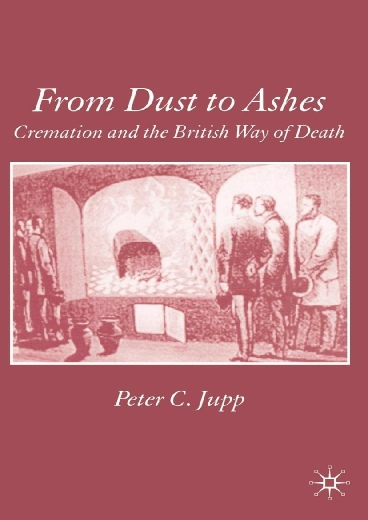

© John Clarke 2014-
John Clarke
Historian of Brookwood Cemetery

From Dust to Ashes

From Dust to Ashes: Cremation and the British Way of Death
by Peter C. Jupp
Published by Palgrave Macmillan, 2006
ISBN 0333692985
Price £65 (hardback), 232pp.
This book is the first account of a fundamental change in death customs in modern Britain, the replacement of burial by cremation. It charts the remarkable progress of this development, since within sixty-
The book is arranged chronologically from the early nineteenth century onwards (although it should be noted the introductory chapter ranges much further back in time). A valuable introductory chapter is followed by a discussion of how the Church of England lost its monopoly of burial by 1852. The next chapter describes the developments which resulted in the legalisation of cremation by 1884. The early years of cremation in modern Britain are then described, taking the story down to 1914. Subsequent chapters continue this theme by analysing the periods 1914-
Jupp has identified five main themes within his survey and which help explain the shift from burial to cremation in modern Britain. These are: (1) the identification of the disposal of the dead as a matter of public health rather than religion; (2) the need for cremation to be legal; (3) the economics of cremation and burial, a factor which became increasingly important over time; (4) the argument that cremation allowed land space to be retained for the living; and (5) the increasing secularisation of Britain during the period covered by his survey, a fundamental point being the surrender by the church of its monopoly over burial, a change which began with the rise of the cemetery movement and concerns over public health.
For your reviewer, the first two chapters proved the most fascinating, interpreting as they do the massive shift from ecclesiastical to secular control of the disposal of the dead. For over 1000 years the church in England had controlled “the rite, site and mode of disposal of the dead” yet surrendered this charge to secular authorities almost without realising it and within a very short period of time. Jupp’s religious background is of enormous benefit in guiding the reader along this path (as he does throughout), and he manages to do so with considerable insight. Moreover Jupp perceptively notes this surrender was not the obvious outcome of the rise of the cremation movement since there was and is no necessary connection between cremation and secularisation since “neither dust nor ashes gave the Almighty problems. What God could create, he could re-
You finish this book realising that Peter Jupp is a master of his subject. Every section is replete with illuminating comments and shrewd assessments of changing trends in custom and taste. Even his preface shines, commenting as it does on the paucity of studies on cremation and crematoria, the similar difficulties with burial studies and cemeteries, before he moves on to comment on the interpretations offered by anthropological and interdisciplinary studies.
My only criticisms of this book are directed at the publishers. The first is the complete absence of illustrations, which I find odd given the high cover price of the book. The only illustration is on the cover and is poorly reproduced. One wonders who was responsible for this, given that the cover design may be fundamental to sales of a book. Secondly is the relatively small page size which I assume has been used as part of the Palgrave Macmillan academic house style. It is unfortunate the publishers decided against a new format specifically designed to promote the many merits of this valuable and readable account of the rise of cremation in modern Britain.
Copyright © 2006 by John M. Clarke. All Rights Reserved